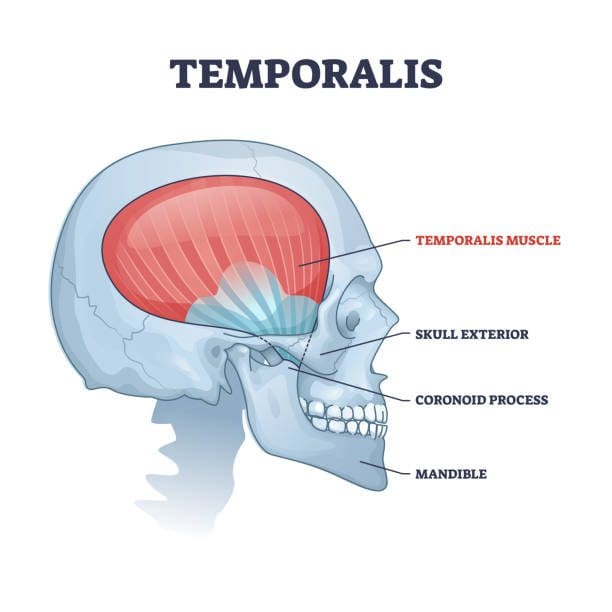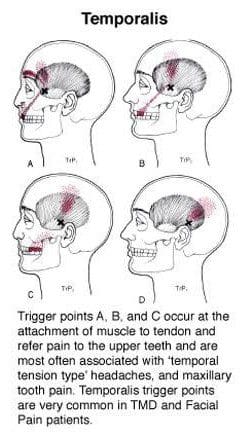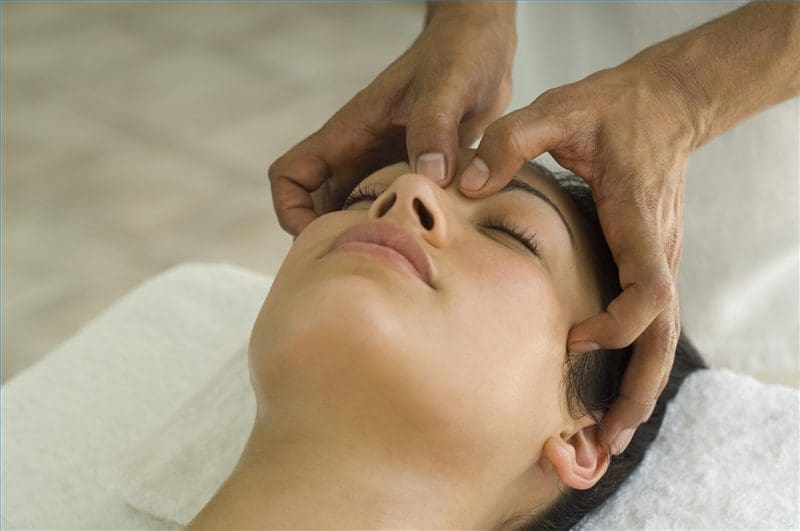Table of Contents
Introduction
Headaches are one of the common issues that affect anyone worldwide. Different issues can cause headaches and affect other individuals depending on the issue. The pain can range from being dull to sharp and affect a person’s mood, sense of belonging, and body. Different headaches can have different effects on people since headaches can be acute or chronic and overlap with other issues affecting the body. To that point, the surrounding muscles and organs around the face may be involved with other conditions where headaches are a symptom rather than a cause. Today’s article examines the temporalis muscle, how trigger pain affects the temporalis muscle, and how to manage the pain associated with trigger points. We refer patients to certified providers who specialize in musculoskeletal treatments to aid individuals suffering from trigger point pain associated with the temporal muscle pain along the side of the head. We also guide our patients by referring them to our associated medical providers based on their examination when appropriate. We ensure to find that education is the solution to asking our providers insightful questions. Dr. Jimenez DC observes this information as an educational service only. Disclaimer
What Is The Temporalis Muscle?
Have you been dealing with a dull or sharp ache on the side of your head? What about the tension that is along your jawline? Or have you been dealing with tooth pain throughout the entire day? Encountering these symptoms can be difficult as they affect the facial region of the head and might overlap with the temporal muscle. The temporalis muscle is part of the mastication muscles, which includes the medial pterygoid, lateral pterygoid, and masseter muscles. The temporalis muscle is a flat, fan-shaped muscle that spans from the temporal fossa to the inferior temporal line of the skull. This muscle converges to form a tendon that surrounds the jaw bone and helps stabilize the jaw and its function by extending and retracting. Studies reveal that the temporalis muscle has two tendons: superficial and deep, in the back of the molars to aid chewing and are attached to the coronoid process (the skin and subcutaneous tissues that cover the superficial tendon of the temporalis muscle and the masseter muscle.) To that point, traumatic and ordinary factors can affect the temporalis muscle and cause symptoms associated with the muscle.
How Do Trigger Points Affect The Temporalis Muscle?
When traumatic or ordinary factors begin to affect the body, including the oral-facial region, it can cause unwanted symptoms to develop over time and, if not treated, make a person’s life miserable. Studies reveal that individuals dealing with chronic tension-type headaches have intense pain from the temporalis muscle. When the temporalis muscle becomes sensitive to the touch, the pain can travel to different body areas. These are known as myofascial or trigger points, and they can be a bit challenging for doctors to diagnose because they can mimic various pain symptoms. Trigger points along the temporalis muscles may potentially affect the teeth and cause headaches to form. Active trigger points in the temporalis muscle could potentially evoke local and referred pain while constituting one of the contributing sources of headache pain. Now how can the temporalis muscle induce chronic tension-type headaches? Well, trigger points are caused when the muscles are overused and can develop tiny knots along the muscle fibers.
Trigger points along the temporalis muscle could potentially induce abnormal dental pain. Studies reveal that abnormal dental pain can be referred to as neurovascular headaches associated with tension on the temporalis muscle. Since trigger points often mimic other chronic conditions that confuse many people about why they are experiencing pain from one section of their body, there are no signs of traumatic encounters. Since trigger points can cause pain to travel from one area of the body to another, many individuals try to find therapeutic ways to alleviate their pain.
An Overview Of The Temporal Muscle- Video
Have you been experiencing headaches that affect your daily activities? Does your jaw seem stiff or tender to the touch? Or have your teeth become extra sensitive when eating certain foods? Many of these symptoms may involve trigger points affecting the temporalis muscle. The video above gives an overview of the anatomy of the temporalis muscle in the body. The temporalis is a fan-shaped muscle that converges into tendons that help make the jaws move. When factors affect the body, especially the temporalis muscle, it can potentially develop trigger points along the muscle fibers. To that point, trigger points can mimic conditions affecting the body, like chronic tension-type headaches and tooth pain. Studies reveal that the pain pressure associated with trigger points along the temporalis muscle is consistently higher when there are different amounts of tooth clenching or jaw gaps. As luck would have it, there are ways to manage temporal muscle pain associated with trigger points.
Ways To Manage Temporal Muscle Pain Associated With Trigger Points
Since trigger points along the temporalis muscle could potentially cause pain in the oral facial region, the surrounding muscles like the upper trapezius and the sternocleidomastoid with their trigger points may cause jaw motor dysfunction and tooth pain. Fortunately, musculoskeletal specialists like chiropractors, physiotherapists, and massage therapists can find where the trigger points are located and use various techniques to alleviate trigger point pain along the temporalis muscle. Studies reveal that soft tissue manipulation can help release the trigger point pressure off of the temporalis muscle and cause relief. Utilizing soft manipulation on myofascial temporalis pain affecting the neck, jaw, and cranial muscles can help reduce headache pain symptoms and help many people feel relief.
Conclusion
The temporalis in the body is a flat, fan-shaped muscle that converges down to the jawline and works with the other mastication muscles to provide the motor function to the jaw. When ordinary or traumatic factors affect the temporalis muscle, it can develop trigger points along the muscle fibers. To that point, it causes pain-like symptoms and even causes referred pain like tension headaches and toothaches in the oral-fascial region of the head. This can make many people suffer in pain unless there are ways to manage the associated symptoms. Fortunately, many musculoskeletal specialists can incorporate techniques that target trigger-point pain related to the affected muscle. When people utilize treatment for myofascial trigger pain, they can get their lives back together.
References
Basit, Hajira, et al. “Anatomy, Head and Neck, Mastication Muscles – Statpearls – NCBI Bookshelf.” In: StatPearls [Internet]. Treasure Island (FL), StatPearls Publishing, 11 June 2022, www.ncbi.nlm.nih.gov/books/NBK541027/.
Fernández-de-Las-Peñas, César, et al. “The Local and Referred Pain from Myofascial Trigger Points in the Temporalis Muscle Contributes to Pain Profile in Chronic Tension-Type Headache.” The Clinical Journal of Pain, U.S. National Library of Medicine, 2007, pubmed.ncbi.nlm.nih.gov/18075406/.
Fukuda, Ken-Ichi. “Diagnosis and Treatment of Abnormal Dental Pain.” Journal of Dental Anesthesia and Pain Medicine, The Korean Dental Society of Anesthsiology, Mar. 2016, www.ncbi.nlm.nih.gov/pmc/articles/PMC5564113/.
Kuć, Joanna, et al. “Evaluation of Soft Tissue Mobilization in Patients with Temporomandibular Disorder-Myofascial Pain with Referral.” International Journal of Environmental Research and Public Health, MDPI, 21 Dec. 2020, www.ncbi.nlm.nih.gov/pmc/articles/PMC7767373/.
McMillan, A S, and E T Lawson. “Effect of Tooth Clenching and Jaw Opening on Pain-Pressure Thresholds in the Human Jaw Muscles.” Journal of Orofacial Pain, U.S. National Library of Medicine, 1994, pubmed.ncbi.nlm.nih.gov/7812222/.
Yu, Sun Kyoung, et al. “Morphology of the Temporalis Muscle Focusing on the Tendinous Attachment onto the Coronoid Process.” Anatomy & Cell Biology, Korean Association of Anatomists, 30 Sept. 2021, www.ncbi.nlm.nih.gov/pmc/articles/PMC8493017/.
Disclaimer
Post Disclaimer
Professional Scope of Practice *
The information herein on "Temporal Headaches & Toothaches" is not intended to replace a one-on-one relationship with a qualified health care professional or licensed physician and is not medical advice. We encourage you to make healthcare decisions based on your research and partnership with a qualified healthcare professional.
Blog Information & Scope Discussions
Welcome to El Paso's Wellness blog, where Dr. Alex Jimenez, DC, FNP-C, a board-certified Family Practice Nurse Practitioner (FNP-C) and Chiropractor (DC), presents insights on how our team is dedicated to holistic healing and personalized care. Our practice aligns with evidence-based treatment protocols inspired by integrative medicine principles, similar to those found on dralexjimenez.com, focusing on restoring health naturally for patients of all ages.
Our areas of chiropractic practice include Wellness & Nutrition, Chronic Pain, Personal Injury, Auto Accident Care, Work Injuries, Back Injury, Low Back Pain, Neck Pain, Migraine Headaches, Sports Injuries, Severe Sciatica, Scoliosis, Complex Herniated Discs, Fibromyalgia, Chronic Pain, Complex Injuries, Stress Management, Functional Medicine Treatments, and in-scope care protocols.
Our information scope is limited to chiropractic, musculoskeletal, physical medicine, wellness, contributing etiological viscerosomatic disturbances within clinical presentations, associated somato-visceral reflex clinical dynamics, subluxation complexes, sensitive health issues, and functional medicine articles, topics, and discussions.
We provide and present clinical collaboration with specialists from various disciplines. Each specialist is governed by their professional scope of practice and their jurisdiction of licensure. We use functional health & wellness protocols to treat and support care for the injuries or disorders of the musculoskeletal system.
Our videos, posts, topics, subjects, and insights cover clinical matters, issues, and topics that relate to and directly or indirectly support our clinical scope of practice.*
Our office has reasonably attempted to provide supportive citations and has identified the relevant research studies or studies supporting our posts. We provide copies of supporting research studies available to regulatory boards and the public upon request.
We understand that we cover matters that require an additional explanation of how they may assist in a particular care plan or treatment protocol; therefore, to discuss the subject matter above further, please feel free to ask Dr. Alex Jimenez, DC, APRN, FNP-BC, or contact us at 915-850-0900.
We are here to help you and your family.
Blessings
Dr. Alex Jimenez DC, MSACP, APRN, FNP-BC*, CCST, IFMCP, CFMP, ATN
email: coach@elpasofunctionalmedicine.com
Licensed as a Doctor of Chiropractic (DC) in Texas & New Mexico*
Texas DC License # TX5807
New Mexico DC License # NM-DC2182
Licensed as a Registered Nurse (RN*) in Texas & Multistate
Texas RN License # 1191402
ANCC FNP-BC: Board Certified Nurse Practitioner*
Compact Status: Multi-State License: Authorized to Practice in 40 States*
Graduate with Honors: ICHS: MSN-FNP (Family Nurse Practitioner Program)
Degree Granted. Master's in Family Practice MSN Diploma (Cum Laude)
Dr. Alex Jimenez, DC, APRN, FNP-BC*, CFMP, IFMCP, ATN, CCST
My Digital Business Card





